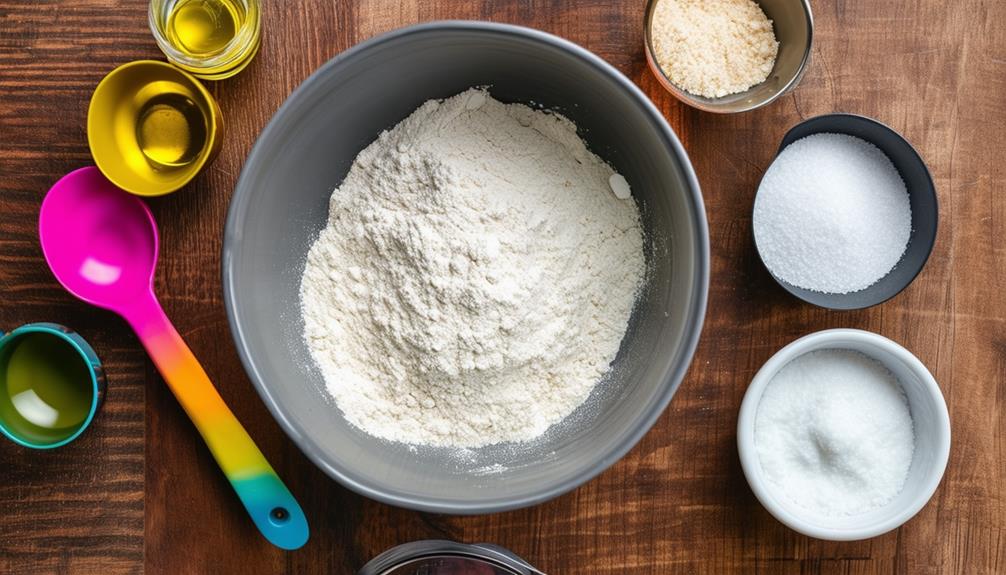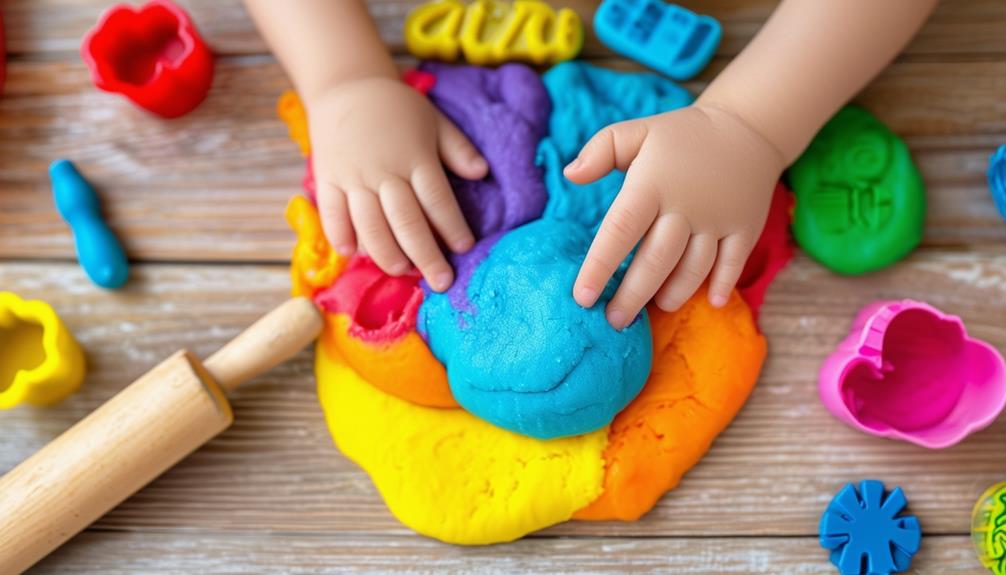How to Make Playdough With Essential Oils

Creating playdough infused with essential oils is a delightful way to combine creativity with the soothing benefits of aromatherapy. Begin by gathering basic ingredients such as flour, salt, and cream of tartar. Select essential oils like lavender or peppermint for their calming properties. The process involves mixing the dry ingredients separately from the wet ingredients before combining them.
To ensure the essential oils are evenly distributed throughout the playdough, add the oils to the wet ingredients before mixing them with the dry ones. This helps to incorporate the aroma uniformly. For preserving the fragrance and consistency of the playdough over time, store it in an airtight container and occasionally knead it to refresh its texture. Let's explore the steps in detail to create the perfect sensory experience.
Ingredients
To make aromatic playdough with essential oils, you'll need a few basic ingredients. Gather flour, salt, cream of tartar, water, vegetable oil, and food coloring. These ingredients form the base of your playdough, ensuring it has the right texture and consistency for molding and playing.
Once you've got your base ingredients ready, you can move on to the fun part: adding essential oils. Essential oils not only add a delightful scent to your playdough but can also offer therapeutic benefits. For instance, lavender oil is known for its calming properties, while peppermint can be invigorating. Lemon and wild orange provide an uplifting and fresh aroma, making playtime even more enjoyable.
To incorporate essential oils into your playdough, add a few drops directly into the mixture before kneading. This allows the oils to blend evenly, giving the playdough a consistent scent. Be mindful of the amount you use; a little goes a long way. The scent from the essential oils will engage your sense of smell, providing a personalized sensory experience that can aid in relaxation, stress relief, or mood enhancement. Now, let's get started with your aromatic playdough adventure!
Essential Oils Selection
Selecting the right essential oils for your playdough can significantly enhance its aromatic and therapeutic qualities. When crafting aromatherapy playdough, you have a variety of essential oils to consider, each offering distinct benefits. Popular choices include Lavender, Rosemary, Chamomile, Frankincense, and Vetiver. Lavender is renowned for its relaxation properties, making it perfect for calming activities. Rosemary aids in focus and mental clarity, while Chamomile is excellent for stress relief.
Customizing the scent of your playdough allows you to tailor the experience to your specific needs. For relaxation, opt for Lavender or Chamomile. For an invigorating effect, try a blend of Rosemary and Frankincense. Vetiver is fantastic for grounding and promoting a sense of calm, making it suitable for evening play sessions. The goal of aromatherapy playdough is to engage both the sense of smell and touch, creating a full sensory experience.
Proper storage is crucial for maintaining the efficacy of the essential oils. Keep your playdough in an airtight container and use it within a week to ensure the scent remains potent and the therapeutic benefits are preserved.
Mixing Dry Ingredients

Begin by thoroughly mixing 1 cup of flour, 1/2 cup of salt, and 2 teaspoons of cream of tartar in a bowl. This step is crucial for achieving a smooth texture and ensuring the playdough has the right elasticity and consistency once heated.
Ingredient Proportions Matter
Accurate measurement and thorough blending of flour, salt, and cream of tartar are essential for achieving the ideal playdough texture. Each ingredient plays a distinct role, and their proportions directly affect the playdough's consistency and usability.
Flour provides the primary structure of the playdough. Salt adds weight and acts as a preservative. Cream of tartar enhances elasticity and pliability, making the dough easier to shape and mold.
Proper proportions and thorough blending matter for several reasons:
- Consistency: Ensures the playdough is neither too sticky nor too crumbly.
- Texture: Results in a smooth final product.
- Elasticity: Enhances the dough's stretchiness with the right amount of cream of tartar.
Correctly measuring and combining these dry ingredients sets a strong foundation for incorporating essential oils and other components later. This attention to detail ensures your homemade playdough is enjoyable, durable, and easy to handle.
Sifting for Smooth Texture
Sieving the flour, salt, and cream of tartar is crucial for achieving a smooth texture in your playdough. Begin by accurately measuring each dry ingredient. Place a fine-mesh sieve over a large mixing bowl, and first add the flour. Gently tap or shake the sieve to sift the flour into the bowl. Repeat this process with the salt and then the cream of tartar.
Sieving ensures that all ingredients mix evenly, which is essential for a consistent dough. The cream of tartar is particularly important because it adds elasticity and smoothness, binding the flour and salt to create a pliable and soft texture perfect for molding and shaping.
After sieving, stir the sifted ingredients together using a whisk or spoon to ensure even distribution. Properly mixed dry ingredients are the foundation for high-quality playdough, free from clumps and lumps. Taking the time to sieve sets you up for a successful and enjoyable playdough-making experience.
Combining Before Heating
Before heating, ensure you thoroughly mix the dry ingredients to create a smooth and aromatic playdough. This crucial step ensures that the oils blend seamlessly, providing a consistent and delightful scent throughout the batch.
Begin by combining flour, salt, and cream of tartar in a large mixing bowl. Proper blending of these ingredients forms a solid foundation for your playdough, ensuring even distribution of both dry components and essential oils. Follow these steps:
- Flour: Serves as the base, providing the bulk and structure of the playdough.
- Salt: Preserves the playdough and adds texture.
- Cream of Tartar: Ensures a smooth and pliable consistency, making the playdough easier to mold and play with.
Combining Wet Ingredients
Begin by simmering water, olive oil, and your chosen essential oils in a pot to create a richly infused aromatic base for your playdough. This step is crucial because the water and olive oil establish a foundation that allows the essential oils to spread evenly throughout the playdough. Simmering these components together ensures that the scents from the essential oils are thoroughly blended, providing a consistent and delightful aroma.
Stir the mixture well as it simmers to uniformly disperse the essential oils, ensuring that every part of the playdough will have the same therapeutic fragrance. This process is not just about mixing but infusing, creating a sensory experience that is both aromatic and comforting.
Once the ingredients are thoroughly mixed and the fragrances have been infused, you'll notice a distinct, pleasant scent emanating from the pot. This fragrant base sets the stage for a playdough that is enjoyable to mold and shape while delivering a calming, sensory experience. Now you're ready to proceed to the next steps, incorporating these infused wet ingredients into your playdough mixture.
Adding Essential Oils

When adding essential oils to your playdough, choose oils that align with your desired scent and therapeutic benefits. Popular options include lavender for relaxation, peppermint for energy, and lemon for a fresh, uplifting aroma. Knead the oils thoroughly into the prepared playdough to ensure an even distribution of scent and benefits.
Choosing the Right Oils
Selecting the right essential oils for your playdough can significantly enhance the sensory experience and tailor it to specific needs or moods. Essential oils offer various aromatherapy benefits, creating unique, enriching scents for playtime. For a calming effect, consider using oils like Lavender or Chamomile, known for their relaxing properties. These can be particularly beneficial for creating a soothing atmosphere.
If you aim to energize and invigorate, opt for Peppermint or Citrus oils such as Lemon and Orange. These oils are ideal for enhancing energy and mood, making playtime more dynamic and lively. Additionally, Frankincense can provide grounding benefits, while Rosemary can boost focus and clarity, making them excellent choices for more mindful play sessions.
Keep these points in mind when choosing your oils:
- Evaluate the aromatherapy benefits of each oil.
- Experiment with different combinations to create unique scents.
- Align your oil choice with the desired mood or impact.
Incorporating Oils Effectively
To incorporate essential oils effectively into playdough, start by removing the playdough from the heat and allowing it to cool slightly. This is crucial, as adding essential oils to hot dough can reduce their therapeutic benefits. Once the dough has sufficiently cooled, add a few drops of your chosen essential oils. It's advisable to start with a small amount because you can always add more if the scent is not strong enough.
Next, knead the dough thoroughly to ensure the oils are evenly distributed. This step not only disperses the scent throughout the playdough but also maximizes the aromatherapy benefits. Kneading is essential for achieving a uniform texture and consistent scent, allowing the playdough to provide the desired effects, whether it is relaxation, focus, or mood enhancement.
During the kneading process, you will naturally inhale the soothing scents, enriching the overall experience. This simple activity transforms ordinary play into a sensory-rich experience, offering both enjoyment and holistic benefits.
Cooking the Dough
Start by heating a mixture of water, oil, flour, salt, and cream of tartar in a pot on the stove. This step is crucial for ensuring your playdough has the right texture and consistency. Use medium heat and continuously whisk the mixture to prevent clumping. The consistency should gradually become smooth and lump-free.
Key points to remember:
- Simmering time: Typically takes 5-10 minutes.
- Consistency check: Stir until the dough pulls away from the pot's sides.
- Whisking technique: Continuous whisking is essential for even mixing.
Different cooking methods and pot brands may affect your results, but maintaining steady, consistent heat is vital. If lumps appear, keep whisking until the mixture smooths out. After cooking, the dough should be pliable and non-sticky. You can add a few drops of essential oils for aromatherapy benefits at this stage.
Transfer the ready dough to an airtight container to keep it fresh and prevent it from drying out, ensuring it remains soft and usable for an extended period.
Cooling and Kneading

After transferring the cooked dough to an airtight container, allow it to cool for 5-10 minutes. This cooling period is essential for safety, as the dough will be very hot initially. Ensure it remains warm enough to be easily kneaded.
Begin the kneading process by adding a few drops of your chosen essential oils to the dough. As you knead, the aroma will become more pronounced. Kneading is crucial for evenly distributing the essential oils throughout the dough, ensuring a consistent scent. Use your hands to fold, press, and stretch the dough, allowing the oils to fully integrate.
Taking your time during the cooling and kneading process ensures safety, even distribution, and activates the aromatherapy benefits of the essential oils. Properly kneaded playdough can provide a soothing and calming sensory experience, ideal for stress relief or creative play.
Storage Tips
For optimal freshness, store your playdough in airtight containers to retain its moisture and scent. Keeping the containers in the fridge can significantly extend the playdough's lifespan, ensuring it remains soft and aromatic for months. Proper storage is key to maintaining the quality of your homemade playdough.
Airtight Container Benefits
Storing your playdough in an airtight container helps maintain its freshness, softness, and fragrance for extended periods. This simple storage solution is essential for preserving the quality of your homemade playdough, especially if it includes aromatic oils. An airtight container ensures the playdough remains moist, keeping it flexible and prolonging its lifespan.
Key benefits of using an airtight container for your playdough include:
- Freshness: The container protects against air and moisture exposure, preventing the playdough from hardening or losing its aroma.
- Aromatherapy: Aromatic oils incorporated in the playdough retain their scent longer, providing a consistent aromatherapy experience.
- Hygiene: Airtight containers keep the playdough clean and shield it from dust and other contaminants, ensuring a safe and enjoyable playtime.
Fridge Storage Longevity
Storing your playdough in the fridge significantly extends its shelf life, keeping it soft and fragrant for months. Using an air-tight container prevents it from drying out and helps maintain its texture and scent. Aromatherapy oils in the playdough retain their therapeutic benefits longer when kept cool.
To optimize longevity, always store playdough in an air-tight container before refrigerating. This keeps out air and moisture, preventing hardening or spoilage. If your playdough starts to dry out, adding a drop of aromatherapy oil or a few drops of water can restore its softness and aroma.
Refrigeration is especially beneficial for playdough with aromatherapy oils, as the cool environment preserves the oils' healing properties. With proper storage, your homemade playdough can last at least three months, offering prolonged creative and aromatic playtime. So, remember to refrigerate your playdough to keep it fresh and fun longer!
Benefits of Aromatherapy Playdough

Imagine the comforting blend of touch and scent as you work with aromatherapy playdough, experiencing its healing benefits. By integrating aromatic oils, this playdough offers a rich sensory experience that can greatly enhance your well-being. Aromatic oils like lavender, rosemary, and chamomile are often added to help alleviate anxiety and promote relaxation.
The tactile quality of playdough, combined with soothing scents, provides multiple benefits:
- Anxiety Relief: The calming fragrance of oils like lavender can help decrease stress and foster a sense of tranquility.
- Physical Relief: Manipulating playdough can be beneficial for those with arthritis, providing gentle exercise for the hands.
- Sinus Congestion: Oils like eucalyptus can aid in clearing nasal passages, making breathing easier.
Personalization is another significant benefit of aromatherapy playdough. You can customize the oils to suit your specific needs and preferences, creating a tailored sensory experience. Additionally, storing your playdough in a sealed container ensures its freshness, allowing you to continue enjoying its therapeutic effects over time.
Creative Play Ideas
Enhance your playtime by incorporating essential oils into your playdough, creating a unique and therapeutic sensory experience. Adding essential oils like lavender, peppermint, or lemon can offer diverse benefits, from relaxation to increased focus. These scents engage the sense of smell and provide therapeutic advantages, making playtime both enjoyable and beneficial.
Experiment with different essential oil combinations to personalize the playdough's scent to suit specific needs or moods. Encourage children to explore and play with these scented playdoughs, promoting sensory stimulation and making aromatherapy an interactive and enjoyable activity. Here are some creative ideas:
| Essential Oil | Play Idea |
|---|---|
| Lavender | Create calming shapes like stars and hearts for relaxation. |
| Peppermint | Mold letters and numbers to boost focus during learning activities. |
| Lemon | Shape suns and flowers to increase energy and mood. |
| Eucalyptus | Craft trees and leaves for a revitalizing, invigorating play. |
| Orange | Form animals and fruits to inspire creativity and joy. |
Using aromatherapy playdough as a creative tool can transform ordinary play into a delightful, multi-sensory experience. These simple yet effective ideas foster relaxation, focus, and engagement, making playtime enriching for children and adults alike.




